
New Math: Division & Multiplication Problems
July 25, 2017
By Jack Roberts
MHSAA Executive Director
This is the second part in a series on MHSAA tournament classification, past and present, that will be published over the next two weeks. This series originally ran in this spring's edition of MHSAA benchmarks.
High school tournament classifications went viral before there was social media and most of us knew what “viral” meant.
Much as a virus infects computers today or has created epidemics of disease around the world for centuries, high school tournament classification – once introduced – tends to spread uncontrollably. Once started, it tends to keep expanding and rarely contracts.
While we are still some distance from providing every team a trophy as a result of expanding high school tournament classification across the country, there is criticism nevertheless that we are headed in that direction – a philosophy which is supposed to exist only in local youth sports for our youngest children.
Michigan could be blamed for all this. Michigan is generally accepted as the first state to provide different classifications for season-ending tournaments for different sized schools. It started a century ago. Today, every state has various classifications for its tournaments in most if not all sports. And it is a bit ironic that Michigan – creator of the classification chaos – more than most other states has kept the number of tournament classes or divisions under control.
Yes, there is evidence that tournament classifications have expanded over the years in Michigan, especially with the relatively recent introduction of tournaments in football and the late 1990s’ move from classes to divisions in most MHSAA tournaments. But the MHSAA Representative Council has held true to its word when it expanded the playoffs for football from four classes to eight divisions: this is needed because of unique factors of football, factors that exist in no other sport; and all other sports should be capped at a maximum of four classes or divisions.
Kentucky is the preeminent defender of single-class basketball. All of its 276 high schools compete for the single state championship for each gender. In Indiana, there are still open wounds from its move in 1998 from one to four classes for its 400 schools in basketball.
Multi-class tournaments have tended to increase the number of non-public school champions, which some states are trying to lower through enrollment “multipliers,” and also tend to increase the number of repeat champions, which some states are trying to affect with “success factors” which lift smaller schools into classifications for larger schools if they take home too many trophies.
While there is considerable evidence that state tournaments do as much bad as good for educational athletics, state associations persist in providing postseason tournaments because, on balance, the experiences are supposed to be good for student-athletes. And once we reach that conclusion it is just a small leap to believe that if the tournaments are good for a few, they must be better for more – which leads to creating more and more tournament classifications. One becomes two classes, then three, then four and so forth.
While the argument is that more classifications or divisions provides more students with opportunities to compete and win, it is undeniable that the experience changes as the number of tournament classifications expands. It is not possible for state associations to provide the same level of support when tournament classifications expand to multiple venues playing simultaneously. For example, there is less audio and video broadcast potential at each venue, and less media coverage to each venue. Focus is diluted and fans diminished at each championship.
No one can argue reasonably that today's two-day MHSAA Football Finals of eight championship games has the same pizazz as the one-day, four-games event conducted prior to 1990.
In some states the number of divisions has grown so much that it is difficult to see much difference between the many season-ending state championship games and a regular-season event in the same sport.
It is a balancing act. And Michigan has been studying that balance longer than any other state, and charting a steadier course than most.
Addition by Division
The shift to Divisions for MHSAA Tournament play in numerous sports has added up to a greater number of champions for teams and individuals across the state. Following are the sports currently employing a divisional format, and the procedures for determining enrollment and classification.
In 23 statewide or Lower Peninsula tournaments, schools which sponsor the sport are currently divided into nearly equal divisions. They are:
- Baseball - 4 Divisions
- Boys Bowling - 4 Divisions
- Girls Bowling - 4 Divisions
- Girls Competitive Cheer - 4 Divisions
- LP Boys Cross Country - 4 Divisions
- LP Girls Cross Country - 4 Divisions
- LP Boys Golf - 4 Divisions
- LP Girls Golf - 4 Divisions
- Ice Hockey - 3 Divisions
- Boys Lacrosse - 2 Divisions
- Girls Lacrosse - 2 Divisions
- Boys Skiing - 2 Divisions
- Girls Skiing - 2 Divisions
- LP Boys Soccer - 4 Divisions LP
- Girls Soccer - 4 Divisions
- Girls Softball - 4 Divisions
- LP Boys Swimming & Diving - 3 Divisions
- LP Girls Swimming & Diving - 3 Divisions
- LP Boys Tennis - 4 Divisions
- LP Girls Tennis - 4 Divisions
- LP Boys Track & Field - 4 Divisions
- LP Girls Track & Field - 4 Divisions
- Wrestling - 4 Divisions
Lists of schools for each division of these 23 tournaments are posted on MHSAA.com approximately April 1. Listings of schools in Upper Peninsula tournaments for their sports are also posted on MHSAA.com. The lists are based on school memberships and sports sponsorships in effect or anticipated for the following school year, as known to the MHSAA office as of a date in early March.
In football, the 256 schools which qualify for MHSAA 11-player playoffs are placed in eight equal divisions annually on Selection Sunday. Beginning in 2017, the 8-player divisions will be determined in a like manner on Selection Sunday as well, with 32 qualifying schools placed in two divisions.
Schools have the option to play in any higher division in one or more sports for a minimum of two years.
The deadlines for "opt-ups" are as follows:
- Applications for fall sports must be submitted by April 15
- Applications for winter sports must be submitted by Aug. 15
- Applications for spring sports must be submitted by Oct. 15
Subsequent to the date of these postings for these tournaments, no school will have its division raised or lowered by schools opening or closing, schools adding or dropping sports, schools exercising the option to play in a higher division, or approval or dissolution of cooperative programs.
When the same sport is conducted for boys and girls in the same season (e.g., track & field and cross country), the gender that has the most sponsoring schools controls the division breaks for both genders.
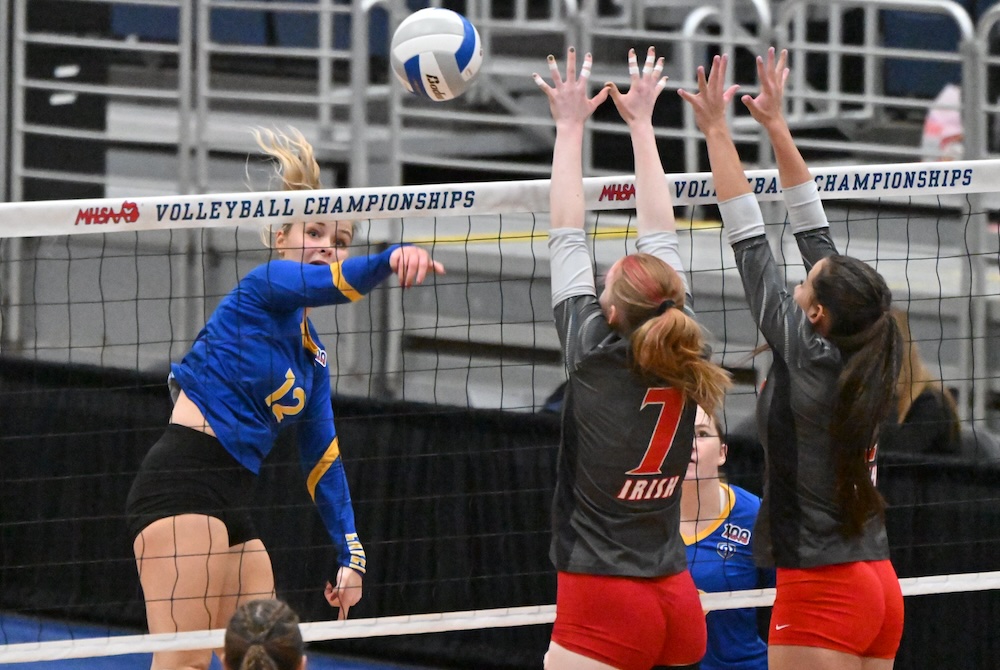
Story in Photos: 2024 Volleyball Division 1 & 4 Semifinals
By
Geoff Kimmerly
MHSAA.com senior editor
November 21, 2024
BATTLE CREEK – The matchups for this season’s Division 1 and 4 Volleyball Finals are set after Thursday’s Semifinals at Kellogg Arena, with the possibility of first-time champions in both divisions, a reigning champion playing to repeat in near-perfect fashion and a past champion pursuing its first title in more than a decade.
Saturday’s first two Finals will see the following face off at Kellogg Arena:
10 a.m. – Division 4 – Clarkston Everest Collegiate (37-0-1) vs. St. Joseph Our Lady of the Lake Catholic (33-3-1)
Noon – Division 1 – Northville (40-2) vs. Rockford (40-9)
Everest is the reigning champion in Division 4 and attempting to become the first Finals winner to also finish undefeated since 2015. The Mountaineers face Our Lady, which will play in its first championship match.
Northville is seeking its first Finals title as well, and finished runner-up in 2022. Rockford is seeking its second championship, to go with its Class A title won in 2011.
Division 2 and 3 Semifinals will be played Friday. Click here for more.
Hockey Weekly Action Photos captured the following from Thursday’s action.
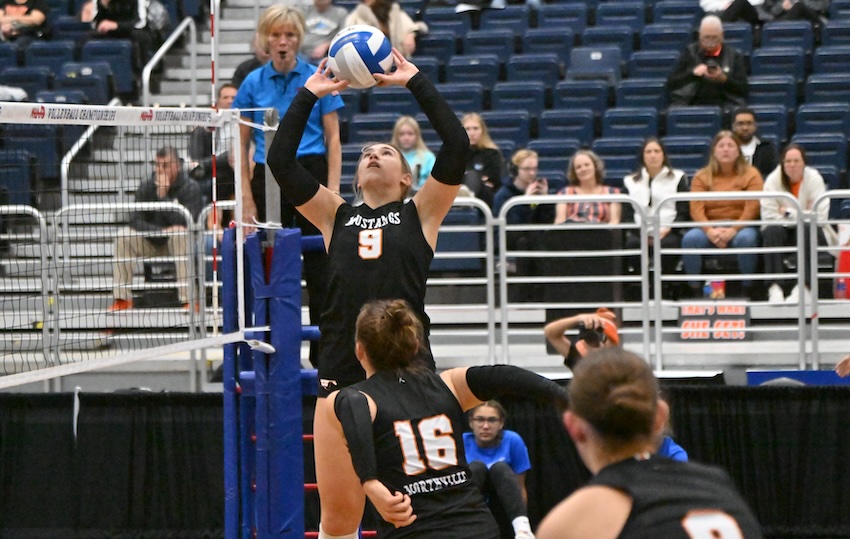
Northville’s Ella Craggs (9) sets for Elle Chenowith (16) during their team’s 25-20, 20-25, 25-19, 25-22 Division 1 Semifinal win over Bloomfield Hills Marian (45-8).
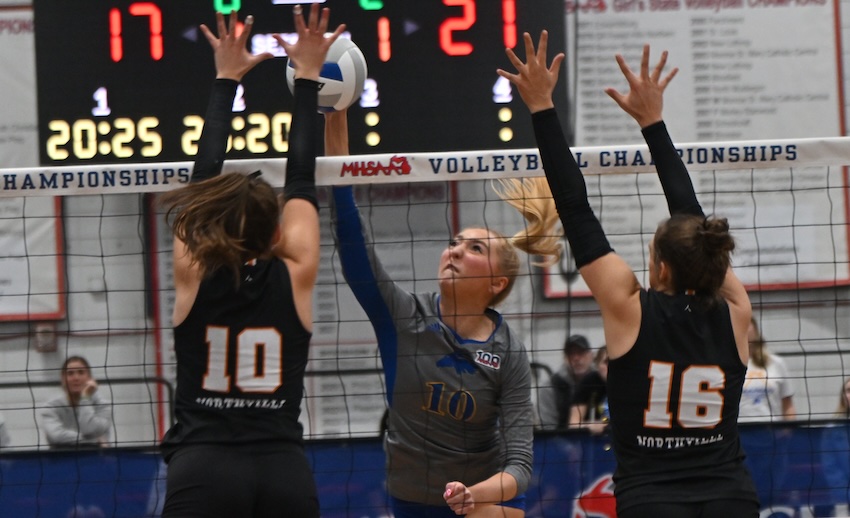
Marian’s Jayla Zayti works to get a ball past Northville’s Mallory Reck (10) and Chenowith (16). Zayti finished with six kills and seven blocks, while Reck had 18 kills and four blocks, and Chenowith had three blocks.
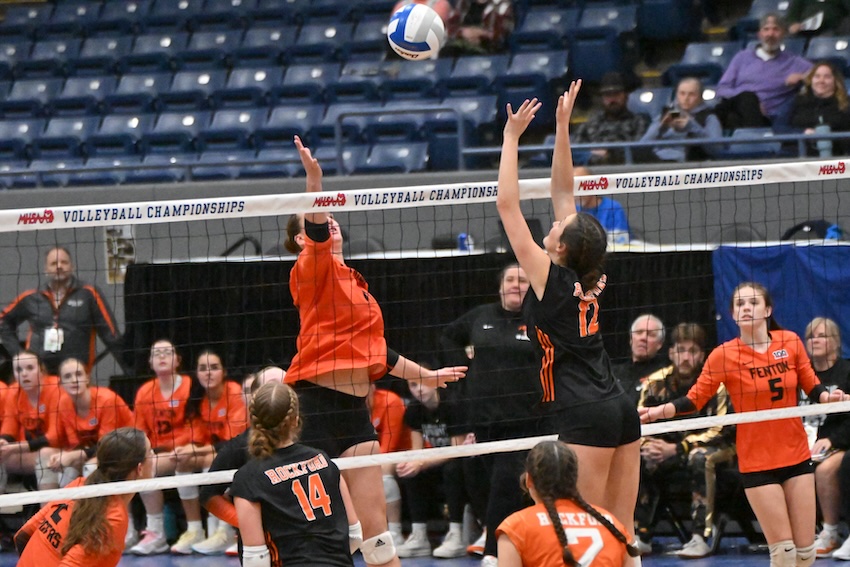
A Fenton player and Rockford's Grace Crelly (12) meet at the net of the second Division 1 Semifinal. Crelly finished with five kills in the Rams’ 25-12, 25-14, 25-8 victory.
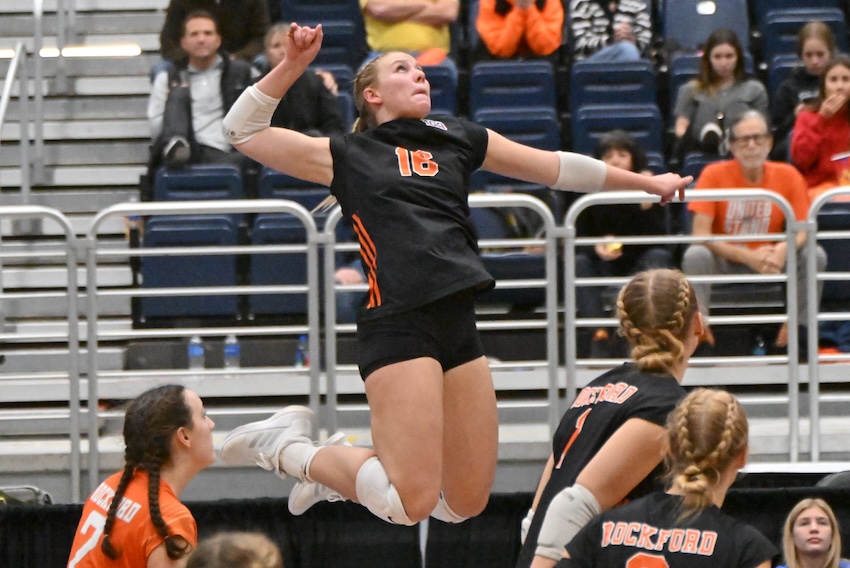
The Rams' Mallory Wandel (16) elevates for a kill attempt against the Tigers (36-5). Wandel finished with 18 kills.
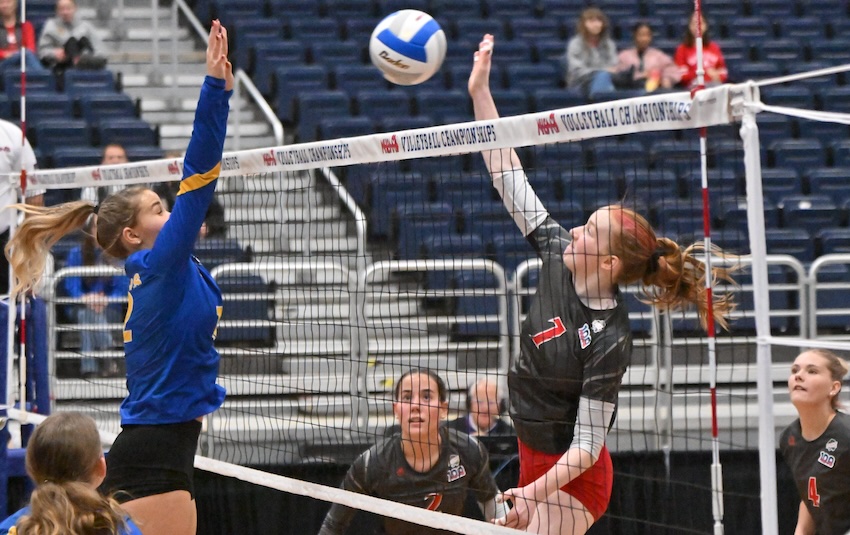
Mount Pleasant Sacred Heart’s Erin Judge (7) sends a kill attempt toward the Our Lady of the Lake side of the court. Judge finished with 13 kills, but the Lakers prevailed 24-26, 25-22, 26-11, 26-28, 15-8. The Irish finished 42-5-2 this fall.

Clarkston Everest Collegiate’s Emmerson Phyle (5) serves during her team’s 25-10, 25-16, 25-13 sweep of Hancock to open the Division 4 Semifinals on Thursday. Phyle had a pair of aces during the match.
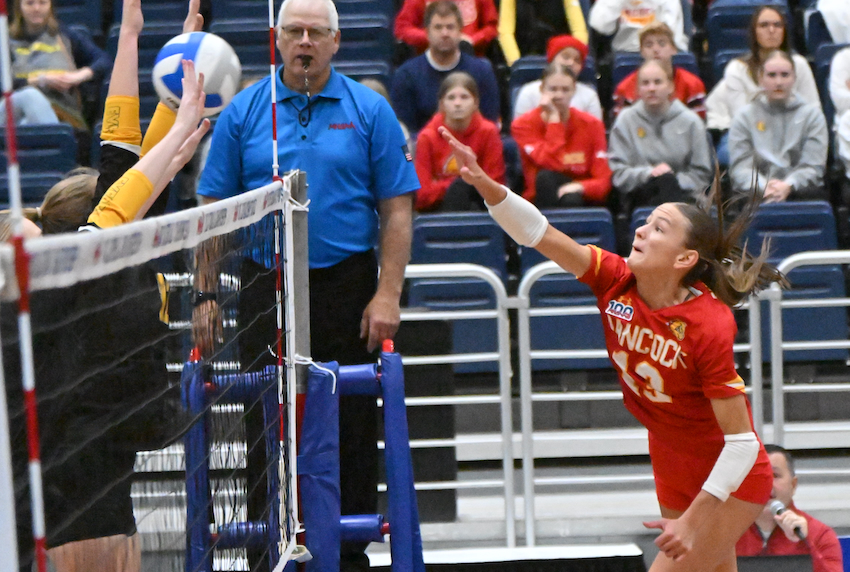
Hancock’s Brooke Koskela (13) puts a ball through an Everest block. Koskela finished with 10 kills for the Gremlins (25-7-2).
TOP PHOTO Our Lady of the Lake’s Nora Proos sends a spike into the block of Judge and another teammate Thursday.

